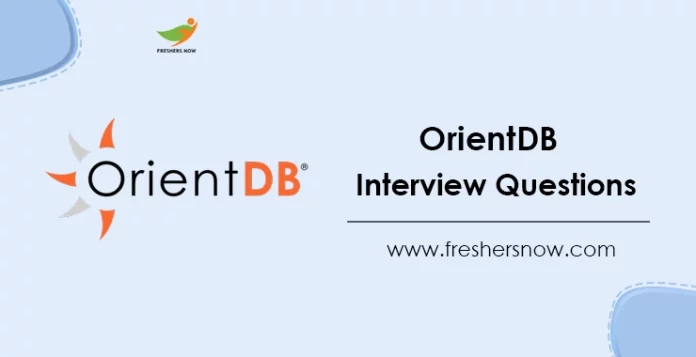
OrientDB Interview Questions and Answers: If you are preparing for an OrientDB interview, it’s important to have a strong grasp of the technology and the various techniques for managing and manipulating data. To help you prepare for your interview, we have compiled a comprehensive list of Top 100 OrientDB Interview Questions and Answers. This list includes the latest OrientDB interview questions, as well as OrientDB technical interview questions and OrientDB interview questions for freshers.
★★ Latest Technical Interview Questions ★★
OrientDB Technical Interview Questions
By reviewing these OrientDB Interview Questions and Answers, you will be better equipped to showcase your knowledge and expertise during your OrientDB interview and increase your chances of landing your dream job in the field of database management.
Top 100 OrientDB Interview Questions and Answers
1. What is OrientDB?
OrientDB is an open-source NoSQL database management system that supports graph, document, and key-value data models.
2. What are the different types of data models supported by OrientDB?
OrientDB supports three types of data models: graph, document, and key-value.
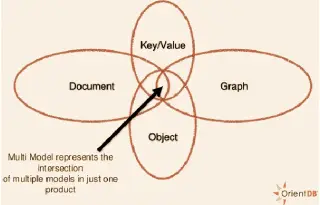
3. How to install OrientDB? Here are the following steps to install OrientDB.
- Download the OrientDB binary setup file, which provides pre-compiled binary packages for various operating systems.
- Extract and install the OrientDB setup file; the file name will vary depending on the operating system, e.g., “orientDB-community-2.1.9.tar.gz” for Linux or “orientdb-community-2.1.9.zip” for Windows.
- Configure OrientDB server as a service based on the operating system’s procedure.
Verify the OrientDB installation in three steps:
- Run the server.
- Run the console.
- Run the studio.
4. How does OrientDB differ from other NoSQL databases?
OrientDB is unique because it supports multiple data models, while most other NoSQL databases specialize in only one type of data model.
5. How do you create a new database in OrientDB?
Answer: You can create a new database in OrientDB using the following command:
| CREATE DATABASE <database_name> |
6. How do you create a new vertex in OrientDB?
Answer: You can create a new vertex in OrientDB using the following command:
| CREATE VERTEX <vertex_class> SET <property_name>=<property_value> |
7. What is sharding in OrientDB?
Sharding in OrientDB is the process of dividing a database into smaller, more manageable pieces called shards.
8. How does OrientDB ensure high availability in a distributed database?
OrientDB ensures high availability in a distributed database by replicating data across multiple nodes and using a quorum-based approach to handle node failures.
9. How do you create a new edge between two vertices in OrientDB?
Answer: You can create a new edge between two vertices in OrientDB using the following command:
| CREATE EDGE <edge_class> FROM <from_vertex> TO <to_vertex> SET <property_name>=<property_value> |
10. How do you delete a vertex and all its edges in OrientDB?
Answer: You can delete a vertex and all its edges in OrientDB using the following command:
| DELETE VERTEX <vertex_id> |
11. What is the role of the coordinator node in a distributed database in OrientDB?
The coordinator node in a distributed database in OrientDB is responsible for managing the distributed query execution, data synchronization, and cluster coordination.
12. How does OrientDB handle conflicts in a distributed database?
OrientDB uses a versioning scheme to handle conflicts in a distributed database. Conflicts are resolved based on the version of the data.
13. What is the difference between a cluster and a class in OrientDB?
A cluster in OrientDB is a physical grouping of records on disk, while a class is a logical grouping of records based on their schema.
14. How do you update the properties of a vertex in OrientDB?
Answer: You can update the properties of a vertex in OrientDB using the following command:
| UPDATE <vertex_id> SET <property_name>=<new_property_value> |
15. How do you query for all vertices of a certain class in OrientDB?
Answer: You can query for all vertices of a certain class in OrientDB using the following command:
| SELECT FROM <vertex_class> |
16. What is a subquery in OrientDB?
A subquery in OrientDB is a query that is nested inside another query.
17. What is a join in OrientDB?
A join in OrientDB is a mechanism that allows you to combine data from multiple classes or clusters in a single query.
18. How do you query for all edges of a certain class in OrientDB?
Answer: You can query for all edges of a certain class in OrientDB using the following command:
| SELECT FROM <edge_class> |
19. How do you filter a query in OrientDB to only return vertices with a certain property value?
Answer: You can filter a query in OrientDB to only return vertices with a certain property value using the following command:
| SELECT FROM <vertex_class> WHERE <property_name> = <property_value> |
20. How do you order the results of a query in OrientDB?
Answer: You can order the results of a query in OrientDB using the following command:
| SELECT FROM <class_name> ORDER BY <property_name> [ASC|DESC] |
21. How do you limit the number of results returned by a query in OrientDB?
Answer: You can limit the number of results returned by a query in OrientDB using the following command:
| SELECT FROM <class_name> LIMIT <limit_number> |
22. What are the main Features of OrientDB?
- OrientDB is an open-source database and can be installed on any system quickly.
- The database provides write operations at speeds up to 300% better than alternative databases.
- OrientDB implements its SQL engine from scratch, enabling it to optimize query execution and offer better performance.
- The database maintains backward compatibility with its API, making it suitable for production users who may have built applications that use older versions of the API.
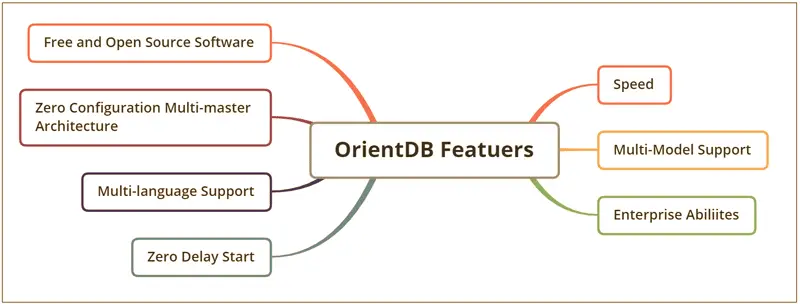
23. What are some advantages of using OrientDB?
- OrientDB integrates multiple database modules into a single database platform.
- The database offers a robust security system based on user profiles.
- Its SQL engine has been built from scratch to enhance performance.
- OrientDB supports storage caching, which reduces latency.
- Remote connections with improved transaction isolation are possible with OrientDB.
24. What is a document in OrientDB?
A document in OrientDB is a JSON-like data structure that contains fields and values.
25. What is a vertex in OrientDB?
A vertex in OrientDB is a node in a graph that represents an entity, such as a person or a product.
26. What is an edge in OrientDB?
An edge in OrientDB is a relationship between two vertices in a graph.
27. How is data stored in OrientDB?
Data in OrientDB is stored in records, which are organized into clusters. Clusters are groups of records that are stored together on disk.
28. What are the different types of data types in OrientDB?
Answer: Below are the different types of data types in OrientDB
- Boolean
- Binary
- Embedded
- Embedded list
- Embedded set
- Date
- Custom
- Decimal
- LinkBag
- Any
- Link list
- Link set
- Link map
- Byte
- Transient
- Date-time
- Integer
- Short
- Long
- Float
- Double
- Embedded map
- Link
- String
29. How does OrientDB handle concurrency control?
OrientDB uses MVCC (multi-version concurrency control) to handle concurrency control.
30. What is the syntax for creating a vertex in OrientDB?
To create a vertex in OrientDB, you can use the following syntax:
| CREATE VERTEX <class-name> [CLUSTER <cluster-name>] [SET <field-name> = <field-value>, …] |
31. What is the syntax for creating an edge in OrientDB?
To create an edge in OrientDB, you can use the following syntax:
| CREATE EDGE <edge-class-name> FROM <from-vertex> TO <to-vertex> [SET <field-name> = <field-value>, …] |
32. What are the differences between OrientDB and Neo4j?
| Differences | OrientDB | Neo4j |
|---|---|---|
| Data Model | Multi-model | Native graph |
| Query Language | Supports both SQL and Gremlin queries | Supports Cypher query language |
| Indexing | Supports multiple indexing options including full-text and spatial indexing | Supports only one type of indexing per label |
| ACID Compliance | Fully ACID compliant | Only supports ACID transactions in the Enterprise version |
| Clustering | Active-active clustering | Active-passive clustering |
| Licensing | Only open-source version available | Open-source and commercial versions |
| Performance | Faster at read-heavy workloads | Faster at write-heavy workloads |
33. What is an index in OrientDB?
An index in OrientDB is a data structure that allows for fast lookups of records based on a particular field or set of fields.
34. What types of indexes does OrientDB support?
OrientDB supports several types of indexes, including unique, non-unique, full-text, and spatial indexes.
35. How do you create an index in OrientDB?
To create an index in OrientDB, you can use the following syntax:
| CREATE INDEX <index-name> ON <class-name> (<field-name>) [UNIQUE] |
36. What is Scaling in OrientDB?
Answer: Scaling in OrientDB refers to the ability of the database to handle increasing amounts of data and traffic by adding additional resources. OrientDB supports both horizontal and vertical scaling. Horizontal scaling involves adding more machines or nodes to a cluster, which allows for better distribution of data and workload. In contrast, vertical scaling involves increasing the resources on a single node, such as adding more RAM or CPU. OrientDB’s active-active clustering model allows for easy horizontal scaling and ensures that all nodes in the cluster are actively serving requests. Additionally, OrientDB’s distributed architecture allows for distributed queries, which further improves scalability by enabling parallel processing of queries across multiple nodes in the cluster. Overall, scaling is an important feature of OrientDB that allows it to handle large and growing datasets with ease.
37. What is a property in OrientDB?
A property in OrientDB is a named attribute of a class or a record that holds a value.
38. What is inheritance in OrientDB?
Inheritance in OrientDB is a mechanism that allows a class to inherit properties and methods from another class.
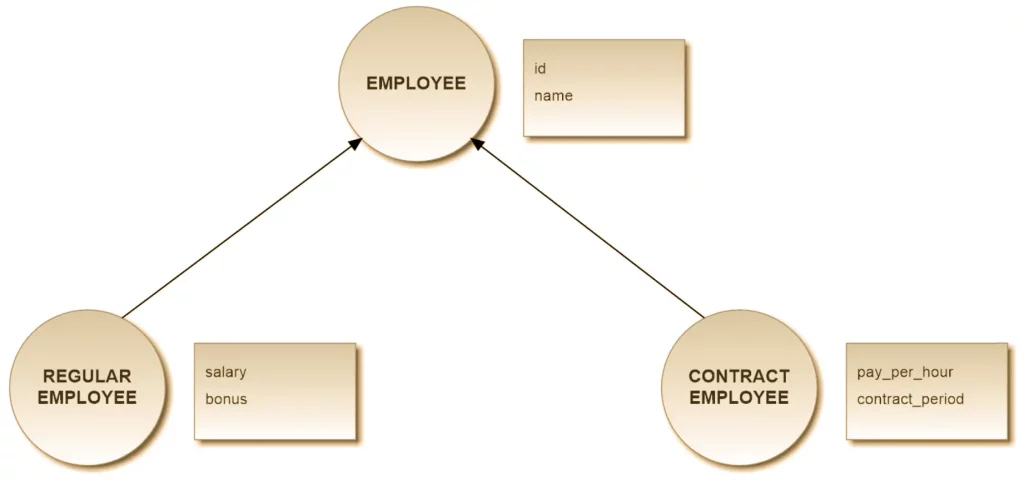
39. What is the syntax for creating a class in OrientDB?
To create a class in OrientDB, you can use the following syntax:
| CREATE CLASS <class-name> [EXTENDS <parent-class-name>] [ABSTRACT] [CLUSTER <cluster-name>, …] [UNSAFE] |
40. What is the syntax for creating a property in OrientDB?
To create a property in OrientDB, you can use the following syntax:
| CREATE PROPERTY <class-name>.<property-name> <property-type> [NOT NULL] [LINKEDTYPE <linked-class-name>] [LINKEDCLASS <linked-class-name>] [UNSAFE] |
41. What is the syntax for inserting a record in OrientDB?
To insert a record in OrientDB, you can use the following syntax:
| INSERT INTO <class-name> SET <field-name> = <field-value>, … |
42. What is the syntax for updating a record in OrientDB?
To update a record in OrientDB, you can use the following syntax:
| UPDATE <record-id> SET <field-name> = <field-value>, … |
43. What is the syntax for deleting a record in OrientDB?
To delete a record in OrientDB, you can use the following syntax:
| DELETE FROM <class-name> WHERE <condition> |
44. What is the syntax for querying data from OrientDB?
To query data from OrientDB, you can use the following syntax:
| SELECT [FROM <class-name>] [WHERE <condition>] [ORDER BY <field-name>] [LIMIT <limit-value>] |
45. What is a stored procedure in OrientDB?
A stored procedure in OrientDB is a block of code that can be executed as a single unit.
46. What is the syntax for creating a stored procedure in OrientDB?
To create a stored procedure in OrientDB, you can use the following syntax:
| CREATE FUNCTION <function-name> [PARAMETERS <parameter-list>] [LANGUAGE <language>] AS <procedure-body> |
47. What is the difference between a stored procedure and a user-defined function in OrientDB?
A stored procedure in OrientDB can contain multiple statements and can perform operations that modify the database, while a user-defined function can only return a value.
48. What is a cluster in OrientDB?
- OrientDB uses clusters to store links to data, which is a way to group records.
- Clusters can be used in a variety of ways to group records, such as grouping records of the same type or grouping frequently accessed records.
- Examples of how clusters may be used include grouping records by type (e.g., “Person”), by frequently accessed records (e.g., “Cache”), by date (e.g., “Today”), or by a specific category (e.g., “CityCar”).
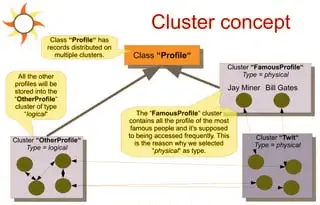
49. What is indexing in OrientDB?
Indexing in OrientDB is a mechanism that allows you to improve the performance of queries by creating data structures that enable faster lookup of data.
50. What is a unique index in OrientDB?
A unique index in OrientDB is an index that enforces uniqueness of values in a property.
51. What is a full-text index in OrientDB?
A full-text index in OrientDB is an index that enables efficient searching of text-based data.
52. What is the difference between a hash index and a tree index in OrientDB?
A hash index in OrientDB is a type of index that is optimized for fast lookups of data, while a tree index is optimized for range queries.
53. What is the difference between a local index and a global index in OrientDB?
A local index in OrientDB is an index that is created on a single node in a distributed database, while a global index is created on multiple nodes.
54. How does OrientDB handle transactions?
OrientDB handles transactions by supporting ACID (Atomicity, Consistency, Isolation, and Durability) transactions.
55. What is a transaction in OrientDB?
A transaction in OrientDB is a sequence of operations that are executed as a single unit of work.
56. What is the syntax for starting a transaction in OrientDB?
To start a transaction in OrientDB, you can use the following syntax:
| BEGIN [ISOLATION <isolation-level>] |
57. What is the syntax for committing a transaction in OrientDB?
To commit a transaction in OrientDB, you can use the following syntax:
| COMMIT [RETRY <retry-count>] |
58. What is the syntax for rolling back a transaction in OrientDB?
To roll back a transaction in OrientDB, you can use the following syntax:
| ROLLBACK [TO SAVEPOINT <savepoint-name>] |
59. What is a savepoint in OrientDB?
A savepoint in OrientDB is a point in a transaction that can be used as a reference for rolling back the transaction to a specific point.
60. What is the role of the OrientDB console?
The OrientDB console is a command-line tool that allows you to interact with the OrientDB database.
61. What is the syntax for connecting to a database using the OrientDB console?
To connect to a database using the OrientDB console, you can use the following syntax:
| CONNECT <database-url> [USER <username> [PASSWORD <password>]] |
62. What is the syntax for creating a database using the OrientDB console?
To create a database using the OrientDB console, you can use the following syntax:
| CREATE DATABASE <database-name> [TYPE <database-type>] [STORAGE <storage-type>] |
63. What is the syntax for importing data into OrientDB using the OrientDB console?
To import data into OrientDB using the OrientDB console, you can use the following syntax:
| IMPORT DATABASE <database-url> [USER <username> [PASSWORD <password>]] <import-file> |
64. What is the syntax for exporting data from OrientDB using the OrientDB console?
To export data from OrientDB using the OrientDB console, you can use the following syntax:
| EXPORT DATABASE <database-url> [USER <username> [PASSWORD <password>]] <export-file> |
65. What is a hot backup in OrientDB?
A hot backup in OrientDB is a backup that can be performed while the database is still running.
66. What is the syntax for performing a hot backup in OrientDB?
To perform a hot backup in OrientDB, you can use the following syntax:
| BACKUP DATABASE <database-url> [USER <username> [PASSWORD <password>]] <backup-directory> |
67. What is the difference between a vertex and an edge in OrientDB?
A vertex in OrientDB represents a node in a graph, while an edge represents a relationship between two nodes.
68. What is the difference between a document and a record in OrientDB?
A document in OrientDB is a data structure that contains one or more records, while a record is a single unit of data stored in a cluster.
69. What is a distributed database in OrientDB?
A distributed database in OrientDB is a database that is spread across multiple nodes in a network.
70. What is a graph database in OrientDB?
A graph database in OrientDB is a database that is optimized for storing and querying graph data.
71. What is the difference between the OrientDB Java API and the OrientDB REST API?
The OrientDB Java API is a programming interface that allows applications to interact with the OrientDB database using Java code, while the OrientDB REST API is a web service that allows applications to interact with the database using HTTP requests.
72. What is the role of the ODatabaseDocumentTx class in the OrientDB Java API?
The ODatabaseDocumentTx class is a Java class that represents a connection to a database in the OrientDB Java API.
73. What is the role of the OGremlinHelper class in OrientDB?
The OGremlinHelper class is a Java class that provides helper methods for writing Gremlin queries in the OrientDB Java API.
74. What is the difference between MongoDB and OrientDB?
| Differences | MongoDB | OrientDB |
|---|---|---|
| Data Model | Document-oriented | Multi-model |
| Query Language | Only supports SQL-like queries | Supports both SQL and Gremlin queries |
| Scalability | Horizontal scaling is easy | Both horizontal and vertical scaling is possible |
| Indexing | Limited indexing options | Supports multiple indexing options including full-text and spatial indexing |
| Licensing | Open-source and commercial versions | Only open-source version available |
75. What is the role of the ODocument class in OrientDB?
The ODocument class is a Java class that represents a document in the OrientDB database.
76. What is the role of the OSQLSynchQuery class in OrientDB?
The OSQLSynchQuery class is a Java class that represents a synchronous SQL query in the OrientDB Java API.
77. What is the role of the OIndex class in OrientDB?
The OIndex class is a Java class that represents an index in the OrientDB database.
78. What is the role of the OCommandSQL class in OrientDB?
The OCommandSQL class is a Java class that represents an SQL command in the OrientDB Java API.
79. What is the role of the OSequence class in OrientDB?
The OSequence class is a Java class that represents a sequence in the OrientDB database.
80. What is the role of the OCluster class in OrientDB?
The OCluster class is a Java class that represents a cluster in the OrientDB database.
81. What is the role of the OSchema class in OrientDB?
The OSchema class is a Java class that represents the schema of the OrientDB database.
82. What is the role of the OIndexManager class in OrientDB?
The OIndexManager class is a Java class that provides methods for managing indices in the OrientDB database.
83. What is the role of the OTraverse class in OrientDB?
The OTraverse class is a Java class that provides methods for traversing the graph data in the OrientDB database.
84. What is the role of the OServer class in OrientDB?
The OServer class is a Java class that represents an OrientDB server instance.
85. What is the role of the OrientDB Distributed Configuration?
The OrientDB Distributed Configuration is a set of parameters that define how the database should be distributed across multiple nodes in a network.
86. What is the role of the OrientDB Distributed Architecture?
The OrientDB Distributed Architecture is a design approach that enables the database to scale horizontally by distributing the data and processing across multiple nodes in a network.
87. What is the role of the OrientDB Replication Configuration?
The OrientDB Replication Configuration is a set of parameters that define how the database should be replicated across multiple nodes in a network.
88. What is the role of the OrientDB Replication Architecture?
The OrientDB Replication Architecture is a design approach that enables the database to ensure high availability and data durability by replicating the data across multiple nodes in a network.
89. What is the role of the OrientDB SQL console?
The OrientDB SQL console is a command-line interface that allows you to execute SQL commands against the OrientDB database.
90. What is the role of the OrientDB console shell?
The OrientDB console shell is a command-line interface that allows you to interact with the OrientDB database using OrientDB-specific commands.
91. What is the role of the OrientDB server?
The OrientDB server is a software component that provides a server instance for the OrientDB database.
92. What is the role of the OrientDB distributed server?
The OrientDB distributed server is a software component that provides a distributed server instance for the OrientDB database.
93. What is the role of the OrientDB client?
The OrientDB client is a software component that allows applications to connect to and interact with the OrientDB server.
94. What is the role of the OrientDB driver?
The OrientDB driver is a software component that allows applications to connect to and interact with the OrientDB database.
95. What is the role of the OrientDB connector?
The OrientDB connector is a software component that allows other software applications to connect to and interact with the OrientDB database.
96. What is the role of the OrientDB ETL?
The OrientDB ETL (Extract, Transform, Load) is a software component that enables the transfer of data from various sources into the OrientDB database.
97. What is the role of the OrientDB plugins?
The OrientDB plugins are software components that extend the functionality of the OrientDB database.
98. What is the role of the OrientDB security features?
The OrientDB security features provide access control and user authentication to ensure the security of the database.
99. What is the role of the OrientDB backup and restore features?
The OrientDB backup and restore features enable the creation of database backups and the restoration of data in the event of a failure.
100. What is the role of the OrientDB monitoring features?
The OrientDB monitoring features provide tools to monitor the performance and health of the database.
The Top 100 OrientDB Interview Questions and Answers provide comprehensive knowledge and understanding of OrientDB, making it easier for individuals to prepare for interviews and enhance their expertise. Kindly follow us on freshersnow.com to acquire further knowledge and insights.



